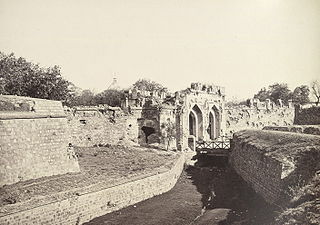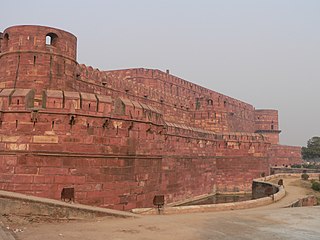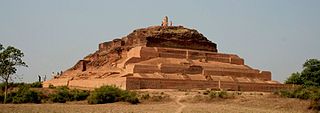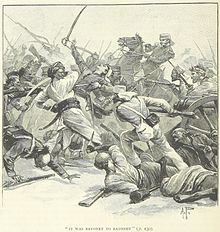
Bahadur Shah II, usually referred to by his poetic title Bahadur Shah Zafar, was the twentieth and last Mughal emperor and an Urdu poet. He was the second son and the successor to his father, Akbar II, who died in 1837. He was a titular Emperor, as the Mughal Empire existed in name only and his authority was limited only to the walled city of Old Delhi (Shahjahanbad). Following his involvement in the Indian Rebellion of 1857, the British deposed him and exiled him to Rangoon in British-controlled Burma in 1858, after convicting him on several charges. The title of Empress of India was subsequently transferred to Queen Victoria.

The Indian Rebellion of 1857 was a major uprising in India in 1857–58 against the rule of the British East India Company, which functioned as a sovereign power on behalf of the British Crown. The rebellion began on 10 May 1857 in the form of a mutiny of sepoys of the company's army in the garrison town of Meerut, 40 mi (64 km) northeast of Delhi. It then erupted into other mutinies and civilian rebellions chiefly in the upper Gangetic plain and central India, though incidents of revolt also occurred farther north and east. The rebellion posed a military threat to British power in that region, and was contained only with the rebels' defeat in Gwalior on 20 June 1858. On 1 November 1858, the British granted amnesty to all rebels not involved in murder, though they did not declare the hostilities to have formally ended until 8 July 1859.
Events in the year 1857 in India.

Brigadier General John Nicholson, was an Anglo-Irish officer in the British Army who rose to prominence during his career in British India. Born in Ireland, Nicholson moved to the Indian subcontinent at a young age and obtained a commission in the East India Company where he spent the majority of his life helping to expand Company rule in numerous conflicts such as the First Anglo-Afghan War and the First and Second Anglo-Sikh War. Nicholson created a legend for himself as a political officer under Henry Lawrence in the frontier provinces of British India, especially in the Punjab, and he was instrumental in the establishment of the North-West Frontier. Nicholson's most defining moment in his military career was his crucial role in suppressing the Indian Rebellion of 1857, a conflict in which he died.

Ahmad Shah Bahadur, also known as Mirza Ahmad Shah or Mujahid-ud-Din Ahmad Shah Ghazi, was the fourteenth Mughal emperor, born to Emperor Muhammad Shah. He succeeded his father to the throne in 1748, at the age of 22. When Ahmed Shah Bahadur came to power, the Mughal Empire started to decline. Furthermore, his administrative weakness eventually led to the rise of the usurping Imad-ul-Mulk.

Shah Alam II, also known by his birth name Ali Gohar, or Ali Gauhar, was the seventeenth Mughal emperor and the son of Alamgir II. Shah Alam II became the emperor of a crumbling Mughal Empire. His power was so depleted during his reign that it led to a saying in the Persian language, Sultanat-e-Shah Alam, Az Dilli ta Palam, meaning, 'The empire of Shah Alam is from Delhi to Palam', Palam being a suburb of Delhi.

Najafgarh is a town in the South West Delhi district of National Capital Territory of Delhi, India. It is one of the three subdivisions of the Southwest Delhi district. Najafgarh is located in south western part of Delhi sharing its territory with Gurgaon and Bahadurgarh, Haryana.

General Bakht Khan (1797–1859) was the commander-in-chief of the Indian rebel forces in the city of Delhi during the Indian Rebellion of 1857 against the East India Company.

The Kabul Expedition was a punitive campaign undertaken by the British against the Afghans following the disastrous retreat from Kabul. Two British and East India Company armies forced through the Khyber Pass and advanced on the Afghan capital from Kandahar and Jalalabad to avenge the complete annihilation of the British-Indian military-civilian column in January 1842.

The Siege of Delhi was one of the decisive conflicts of the Indian Rebellion of 1857. The rebellion against the authority of the East India Company was widespread through much of Northern India, but essentially it was sparked by the mass uprising by the sepoys of the Bengal Army, which the company had itself raised in its Bengal Presidency. Seeking a symbol around which to rally, the first sepoys to rebel sought to reinstate the power of the Mughal Empire, which had ruled much of the Indian subcontinent in the previous centuries. Lacking overall direction, many who subsequently rebelled also flocked to Delhi.
The Central India Campaign was one of the last series of actions in the Indian rebellion of 1857. The British Army and Bombay Army overcame a disunited collection of states in a single rapid campaign, although determined rebels continued a guerrilla campaign until the spring of 1859.

Mirza Mughal, born Muhammad Zahir ud-din Mirza, was a Mughal prince. He played a significant role during the Indian Rebellion of 1857. He was one of the Mughal princes shot dead at one of the gates of Old Delhi, which gate thereafter came to be known as "Khooni Darwaza".
Historians have identified diverse political, economic, military, religious and social causes of the Indian Rebellion of 1857.
The Battle of Badli-ki-Serai was fought early in the Indian Rebellion of 1857, or First War of Indian Independence as it has since been termed in Indian histories of the events. A British and Gurkha force defeated a force of sepoys who had rebelled against the British East India Company. The British victory allowed them to besiege and ultimately capture Delhi.

The Battle of Agra was a comparatively minor but nevertheless decisive action at the end of a prolonged siege during the Indian Rebellion of 1857.

Hafiz Rahmat Khan was the Regent of Rohilkhand in North India, from 1749 to 1774. He was a Pashtun by background, ruling over Rohillas. Hafiz Rahmat Khan had served honorably throughout the reign of three Mughal Emperors: Ahmad Shah Bahadur, Alamgir II and Shah Alam II. He was also a mentor of Prince Mirza Jawan Bakht.

According to the epic Mahābhārata, Bareilly region (Panchala) is said to be the birthplace of Draupadi, who was also referred to as 'Panchali' by Kṛṣṇā. When Yudhishthira becomes the king of Hastinapura at the end of the Mahābhārata, Draupadi becomes his queen. The folklore says that Gautama Buddha had once visited the ancient fortress city of Ahicchattra in Bareilly. The Jain Tirthankara Parshva is said to have attained Kaivalya at Ahichhatra.
The Battle of Jajau was fought between the two Mughal princes and brothers Bahadur Shah I and Muhammad Azam Shah on 20 June 1707. In 1707, their father Aurangzeb died without having declared a successor; instead leaving a will in which he instructed his sons to divide the empire between themselves. Their failure to reach a satisfactory agreement led to a military conflict. After Azam Shah and his three sons were killed in the Battle of Jajau, Bahadur Shah I was crowned as the Mughal emperor on 19 June 1707 at the age of 63.
Mirza Khair-ud-din Muhammad Khizr Sultan Bahadur was a son of the last Mughal emperor, Bahadur Shah II.
The Indian Rebellion of 1857 was a significant uprising against British colonial rule in India from 1857 to 1858. It was directed against the authority of the British East India Company, which acted as a self-governing entity on behalf of the British Crown. Indian Muslim soldiers, known as sepoys, were instrumental in igniting the rebellion, driven by rumors that the cartridges for their rifles were greased with animal fat, which offended their religious beliefs. In regions such as Awadh, Delhi, Bihar, and Bengal, Muslim leaders emerged as key figures in the uprising. Prominent figures like Bahadur Shah II, the last Mughal emperor, and Maulvi Ahmadullah Shah led significant uprisings against the British, symbolizing a desire for the restoration of Muslim political power.













